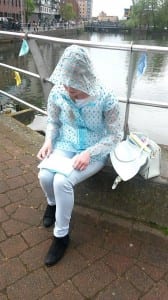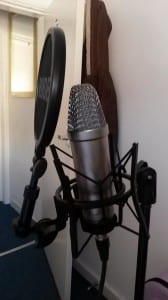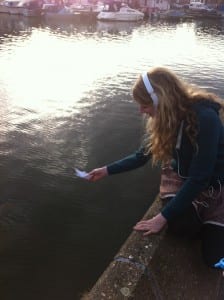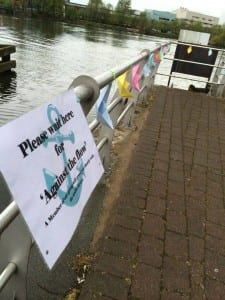We were set an assignment to create a site specific performance, which had to include the theme of liberation and technology. My group consisted of myself, Naomi Jones and Kerry McCarthy. In order to create a successful piece we first needed to understand what the term “site specific performance” meant. “This term refers to a staging and performance conceived on the basis of a place in the real world” (Pavis, 337), i.e. a performance created around the site in which it is to be performed. We were given the option of either using the Lincoln High Street or the Brayford Waterfront. We chose the Waterfront, as we walked by it every day, yet we knew nothing about its history and we were interested in exploring its heritage. In order to create a site specific performance we had to be knowledgeable about the site in which we were going to perform, so we set about researching the Brayford’s long history, spending time in the Collection museum, the Central Library and also researching on the internet.
As we began to get an idea of whom and what shaped the Brayford we see today, we started to envisage what we wanted our performance to be. We liked the idea of doing an audio piece for a single audience member, because it was more personal and intimate than if we were to physically perform in front of a large audience. We researched audio performances by Ports of Call (2008), Carrlands (2007) and Michael Pinchbeck’s “Sit With Me For A Moment And Remember” (2015) in order to gather inspiration for our piece. As a result of this research, we decided we would create an audio experience that would take the audience member on a walk down the Brayford Waterfront, whilst letting them interact with the Brayford in its current state by throwing bird seed into the water to feed the resident birds and eventually launching a small paper boat on to the water so they could add to the layers of history. “The play as event belongs to the space, and makes the space perform as much as it makes the actors perform” (Wiles, 1): using the water and the local wildlife as performers we were making the space perform for us. During the re-telling of the history, the audience would be told about the area in which they stand, with who and what was in their position a hundred, maybe even a thousand years ago. Our ultimate aim for the performance is to hopefully enable the audience to understand just how much history they are standing on and make them see that each step they take is adding more and more layers of history onto the site of the Brayford. The theme of liberation is seen when the audience member walks up the waterfront, going against the flow of the water running beside them – this is the inspiration for the name of our piece: Against The Flow.
Our Site Specific
In order to create a performance which incorporated the Brayford Pool and surrounding area, first we had to have a working knowledge of our site. Researching on the internet turned out to be rather redundant and we did not manage to find much regarding the people who made the history of the Brayford area, more the archaeology of the river itself. We headed out to the Central Library and found a lot of information about the buildings that used to be on the waterfront and the people that worked and lived there, but it was only when we went out on to the waterfront itself and looked did we realise just how much had really changed in only a few decades. The rate of progression and change is quite monumental and it is only when you go out and explore that you truly understand how much a space can change.
As to have a more personal connection to our performance we each went home to find out if where we live was affected by waterways. I live in Hull, so the River Humber is a large part of Hull’s history. “The remains of the past are all around us” (Pearson, 98) the remains of the past are constantly being discovered around the River Humber, Dinosaur fossils are often found, the Romans and Julius Caesar have crossed this river and for hundreds of years it had been used to import and export food and materials all over the world. When I went to the Humber waterfront it was 2°C, raining and very windy, except for the occasional dog walker I was all alone and I allowed my mind to wander. “There is no architecture without event, without program, without violence” (Tschumi, 121). In the shadow of the monolithic Humber Bridge I felt very small and insignificant, however as my mind ticked over I realised that I was not insignificant, but by standing there I was in fact adding another layer to the millions of stories that already inhabited the banks of the river, and that was actually rather comforting. This feeling of being a part of the history of a place was one of our aims for the performance. Tim Etchells states in his Observation/Coincidence fragment of his 8 Fragments – “we pass each other like objects on a projection line.” (Etchells, 79) and we do not notice the area around us or the people we pass, our aim was to change that frame of mind.
https://www.youtube.com/watch?v=KamuKyjF4SA
(Rachel Mudd, 2015)
At first we did not want to be a part of the performance, however as we researched more in to our own history regarding water, we realised we wanted to add a personal touch to our performance, so we decided that since there are three of us there would be three moments within the audio experience where the audience could come and interact with us. In order to find these three moments we took a walk down the Brayford waterfront, one of the things we noticed was that there were people feeding the swans and the ducks. The birds are an integral part of the Brayford Pool so we immediately decided that we would have a moment where one of us would feed the birds and the audience member could come and join us. Kerry took on that moment so myself and Naomi had to think of two more moments where the audience could interact with us. Whilst we were trying to decide, I began absent-mindedly making an origami boat, and it was decided that at the end the audience member could launch a paper boat on to the water as a small homage to the boating legacy that Lincoln has. Naomi would sit at one end of the waterfront, where the audience member would begin, making paper boats and hanging them on the railings next to the water, and I would be at the end, ready to give the audience member a completed paper boat to launch in to the Brayford to complete their journey.
Audio
In order to create a successful audio experience we had to research previous audio performances. We looked in to Ports of Call, which was a tour of the waterways and ports of East London, and since our main focus is the water of the Brayford Pool, it was appropriate to research how they incorporated the theme of water in to their audio. They used first-hand accounts from people who worked on the docks and that gave us the idea to find first-hand accounts of people who worked on the Brayford.
Since the audience were going to be interacting with us we also researched Sit With Me For A Moment And Remember, in which Michael Pinchbeck sat next to the audience member and interacted with them whilst they were still listening to the audio. We needed to write ourselves in to the piece without taking the audience member away from the audio experience.
“Urban spaces in particular are comprised of a multiplicity of past and present traces that coexist on an abundance of visual and auditory trails that, when followed, offer opportunities for creating interventions into the city’s life” (Hahn, 29). In the Central Library we found some first-hand accounts of how the Brayford area looked through various stages of history and the idea of an audio experience began to emerge. The best way to bring these accounts to life was to read them out as if it was the original author, so that was one of the moments in which we decided that our site specific performance would be an audio experience. We found the first-hand account of John Creasey’s Brayford Pool Lincoln (Creasey, J.S) and a 19th Century look at the Brayford in Lincoln’s Waterways (Hall et al, 1983), which were included in our final performance.
My uncle, Ron Dadswell is a mariner who has sailed with the Royal Navy. Although he has never sailed in the Brayford area, he has sailed in the North Sea, which can be directly reached by the Brayford Pool, I asked him about his time sailing and he provided us with many stories about the challenges he faced on the various boats he has been on. “I did a lot of races in the North Sea over many years and you could always guarantee to get some pretty bad weather.” (Mudd, 2015). He provided us with enough material to start to create a script, creating dialogue that could link from the historical first-hand accounts to Ron’s account.
(Clip of interview with Ron Dadswell, 17th March 2015)
We knew we were going to have moments of silence where no one was speaking, so to fill the gap we decided to use the sound of waves. We had already mentioned the North Sea so it seemed appropriate to use the sound of the North Sea waves as the audience member was walking.
(Audio of the North Sea used in our performance. (Hirst, M. 2006))
Writing the Script
We had a base for our script with the first-hand accounts, Ron’s interview and our three moments of audience interaction, but connecting these elements together with a fluid writing style proved quite difficult. Our main theme was the water and boating so we researched nautical terms from an online nautical dictionary (seatalk.info, 2005), and learnt a lot about the language of water.
We needed to learn how to correctly write instructions, so the audience would be clear in where they were heading when we asked them to go to their next location. “Hackney 4th of July” (Lawrence, C., Hunter, M, 2009) is an audio tour that includes instruction, so we read the script in order to find out how we could ask the audience to do something, without seeming like we were forcing them to go “We’re going to make a stop at Ossie’s Café where we’d like you to have a cup of tea, or alternative, at our expense.” (Lawrence, C., Hunter, M, 2009).
Using what we had learnt in our research into the history of the Brayford and surrounding area and the science of water, we began to create a script that flowed and connected the different elements we already had in place.
Recording and Editing
We knew from the beginning that our performance was going to be heavy technically and it proved to be quite challenging. We recorded the dialogue on my Rode microphone and edited it using Audacity. Where we recorded was very important to the quality of the sound. “It is particularly important to minimise early reflections from nearby objects such as tables and walls” (White, 103) – different objects can absorb sound, so in order to get the optimum recording we had to adjust our surroundings, moving furniture and placing the microphone in an area where sound would not be lost.
One of the main problems we faced when recording was the volume levels. The pre-recorded telephone interview with Ron was very loud, and we could not record anything with that volume of noise, so we had to learn how to alter the volume on the different audio tracks. We tested out numerous positions for us to hold the microphone so our voices could be as loud and clear as possible. Throughout the testing process we found that sounds like ‘p’ and ‘b’ made a popping sound when played back: the best way to get rid of this was to alter the angle in which we positioned the microphone and speak to it sideways on.
Our first draft used a reverb, or a type of echo – we wanted to see if we could add the effect to make our voices seem flowy and a bit mystical. This idea didn’t work “reverb should be used very sparingly unless a special effect is sought” (White, 103) so when re-recording we have not use this effect.
(First draft of Against The Flow, 26th March 2015)
Tone of voice is very important as the audience must trust you and feel comfortable when listening to the audio. We experimented with different types of vocal tone and eventually found that we could speak in a way that sounded happy and comforting but also allowed us to successfully tell the audience what we wanted from them. Our first draft was far too formal and in some cases too fast for the audience to understand. Although only recording the sound in my bedroom, nerves were a factor and we were speaking too fast. We needed to learn to control our voices so they were slow enough for the audience to understand.
Trial Runs
Once we had recorded all of our script we took it out on to the Brayford and did a trial run. It was successful and the dialogue was understandable. We were too formal in the way we spoke but that would be rectified when we re-recorded it. The weather was just right for what we needed, however we couldn’t guarantee good weather on the day. We encountered problems such as there was a lot of rubbish floating in the water where we wanted to launch the paper boats, and the boat got caught up in it, however, the next time we went back to the location, the debris has disappeared and it was clear from then on.
The biggest element we needed to improve was the timing of how long it took to walk to the various locations: some breaks were too long, others were too short. To rectify this we walked the route and timed how long it took to walk from one location to the next. Another note we received was that, at twenty five minutes, it was a little too long and we should aim to get it down to twenty. We found that there were sections of dialogue that weren’t needed and could be cut, in the end we managed to cut it down to twenty minutes. Dialogue such as “Due to the close proximity with water the next league will be windy and may result in a rocky voyage so ensure you know where the nearest railing is at all times should sea legs become wobbly.” (Mudd et al. 2015). We included it because it included nautical terms but it wasn’t necessary in moving the dialogue forward.
After these edits, we conducted a second trial run which again, was successful. The timing for the audience member walking to their different locations was a lot better and we reached our destinations in good time. The audio itself was clearer since we had learnt how to speak properly into the microphone and edited it correctly, again there were some notes given where we had to take out more unnecessary dialogue and edit the water sound so it wasn’t overpowering. After this final edit, it was time for our assessed performance.
Final performance
On the day of our final performance there was intermittent rain, which did negatively affect our performance; however we were lucky in that it only rained during one audience member’s experience. We had six audience members over the course of four hours, which was perfect because the performance lasted twenty minutes so we had a five/ten minute break in between to set up again before the next performance. We received a very positive audience reaction, at the last minute we had decided that as a memento for their journey with us, the audience would be given a temporary tattoo that resembled the tattoos mariners would have, and that element received a very positive reaction. We were concerned that we would have trouble in enticing the water fowl towards us with food, but luckily throughout the performances the birds were attracted the food we were throwing to them, and the audience enjoyed feeding them too. One element that worked particularly well and received the most positive reaction was the decoration of the railings with the paper boats, members of the public came up to us and asked us questions about what we were doing, although no one took part they seemed interested in what we were doing.

Paper boar against the Barge on the Brayford Restaurant – 7th May 2015
Our final performance could have been improved by better audio quality. The microphone that we used was good quality; however a more expensive mic could have been better quality. We noticed that during some of the dialogue there was a fuzzy sound that we could not remove and I think that a better quality microphone would rectify that. We would also take White’s advice – “to minimise handling noise, microphones should be mounted on a solid boom stand, and a shock mount cradle should be employed if possible.” (White, 102).
If we were to perform this again we would invest in better audio equipment in order to get the best quality recordings. We would do more trial runs, we only did a couple of trial runs of our performance and each time we received a lot of feedback and things we could have improved, I think if we had done more trial runs whilst we were creating our performance we would have received more feedback and would have been able to improve our performance. We would change the interaction between Kerry and the audience, the place in which the audience was invited to feed the birds was unreliable and it was never guaranteed that there would be birds in that area to feed. Luckily throughout the day there were only two occasions where an audience member had no birds to feed, but having a more reliable interaction where the desired outcome was guaranteed would be an improvement.
This module has opened my eyes to how broad the term “performance” is, it is not limited to doing a play inside a theatre, performance is, in the words of the Pervasive Media Cookbook, “a way of delivering delight and distraction in the midst of day-to-day experience” (pervasivemediacookbook.com, 2012).
Bibliography
Creasey, J.S (1967) Brayford Pool Lincoln. Lincoln
Etchells, T. (1999) Certain Fragments. London: Routledge.
Freesound (2005) North Sea, Whitley Bay. [online] Available from https://www.freesound.org/people/mikehirst/sounds/24047/ [Accessed 9th May 2015]
Hahn, D 2014, ‘Performing Public Spaces, Staging Collective Memory’, TDR: The Drama Review, 58, 3, International Bibliography of Theatre & Dance
Hall, T., Cooper, E., Cunningham, C., Haley, P. (1983) Lincoln’s Waterways – Trail 1. England: Hainton Printing Centre Limited
Lawrence, C., Hunter, M. (2009) A Hackney 4th of July.[online] Available from http://eprints.lincoln.ac.uk/11846/1/AH4oJRecord.pdf [accessed 9th May 2015]
Mackenzie, M (2005) The Dictionary of English Nautical Language. [online] Available from http://www.seatalk.info/ [Accessed 9th May 2015]
Mudd, R (2015) Against The Flow Interview. [telephone call] Conversation with Ron Dadswell, 17 March.
Mudd, R. (2015) Humber Bridge Audio [online video] Available from https://www.youtube.com/watch?v=KamuKyjF4SA [Accessed 9 May 2015]
Mudd, R., Jones, N., McCarthy, K. (2015) Against The Flow.
Pavis, P. (1998) Dictionary of the Theatre: Terms, Concepts, and Analysis (Toronto: University of Toronto Press).
Pervasive Media Studio (2012) Pervasive Media Cookbook [online] Available from http://pervasivemediacookbook.com/ [Accessed 9th May 2015]
Pearson, M (2007) Carrlands [online] Cardiff Bay: Design Stage. Available from http://www.carrlands.org.uk/ [Accessed 9th May 2015]
Pearson, M. (2010). Site Specific Performance. Basingstoke: Palgrave Macmillan.
Pinchbeck, M. (2015) Sit With Me for a Moment and Remember. [performance] Michael Pinchbeck (dir.)
Tschumi, B (1994) The Manhatten Transcripts (London: Academy Editions).
University of East London (2008) Ports of Call: Walks of Art at the Royal Docks. [online] London: University of East London. Available From http://www.portsofcall.org.uk/legal.html [Accessed 9th May 2015]
White, P (2003). Basic Microphones. Wiltshire: Antony Rowe Limited. 103
Wiles, D. (2003) A Short History of Western Performance Space (Cambridge: Cambridge University Press).




